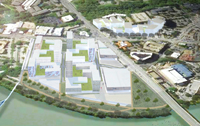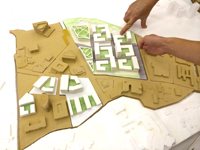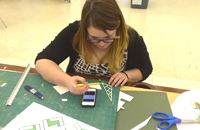Architecture students reimagine Austin’s waterfront
LAWRENCE — Last fall Department of Architecture lecturer Josh Shelton, who teaches a graduate-level architectural design studio, made a presentation on urban master plans at an American Institute of Architects conference.
 In the audience was Alan Holt, principal planner for the city of Austin, Texas, who invited Shelton to participate in its South Central Waterfront Initiative, an effort to plan the development of 97 acres, 30 of which front Lady Bird Lake in the city’s center.
In the audience was Alan Holt, principal planner for the city of Austin, Texas, who invited Shelton to participate in its South Central Waterfront Initiative, an effort to plan the development of 97 acres, 30 of which front Lady Bird Lake in the city’s center.
As a result seven students enrolled in Shelton’s architectural design studio spent the spring semester studying the site, and in April they traveled to Texas to join an Austin Vision + Design Intensive workshop.
 “The city is growing faster than any other city, so this could be one of the most valuable parcels of land in the Southwest,” Shelton said. “Its planning and eventual build-out will have an influence on Austin for generations. Our intent here was to develop great urban spaces for people, not just architecture.”
“The city is growing faster than any other city, so this could be one of the most valuable parcels of land in the Southwest,” Shelton said. “Its planning and eventual build-out will have an influence on Austin for generations. Our intent here was to develop great urban spaces for people, not just architecture.”
Cities use zoning regulations to determine what buildings may be built where. But zoning, particularly if it is outdated, may pit the needs of the public against the rights of owners to maximize the value of their land.
The Vision + Design Intensive brought together the central waterfront’s property owners, the public, architects, real estate developers, even an economist to envision what it might become. Currently office buildings and parking lots occupy the land. But this is being replaced by housing not originally anticipated decades ago.
 Holt noted that without the planning and infrastructure the D+VI was intended to provide, “The public may lose the opportunity to have better access to the lakeshore, walkable connectivity throughout the district and open spaces.”
Holt noted that without the planning and infrastructure the D+VI was intended to provide, “The public may lose the opportunity to have better access to the lakeshore, walkable connectivity throughout the district and open spaces.”
He also added that Austin needs more housing; however, “Property owners are economically driven to build for high-income users. That exacerbates the lack of affordable housing.”
Shelton’s students built a large site model, which was moved to Austin. They also came prepared with studies of the current zoning plans and drawings that became a starting point for many of the conversations that took place.
During the V+DI workshop the students drew up alternative schemes in response to conversations in real time.
“For five days the idea of practice and academia being separate things dissolved,” Shelton said.
“These studies were extremely helpful in fostering communication and building trust,” Holt said. “It was satisfying to see the students negotiate all of these complex conversations about a site that’s under an immense amounts of pressure.”
"As architects we want to make an impact on the world in some way. I guess that taking it to this scale, 97 acres in downtown Austin, that’s a huge impact," said Hannah Dale, a student from Olathe.
At the conclusion of the five-day DV+I workshop, more than 150 people came to a public presentation.
“It was amazing to see how much public interest there was in it,” Dale said, adding that working on a large site was a unique educational experience for her. “I never imagined myself going off and having such a large influence on what happened in a city.”
Students participating in the D+VI were Adam Brcic, St. Louis; Hanah Dale, Olathe; Courtney Fels, Cape Girardeau, Mo.; June You, Lawrence; Henry Lennon and Hart Sanders, Branson, Missouri; and Ryan Sudhoff, Maryville, Missouri.